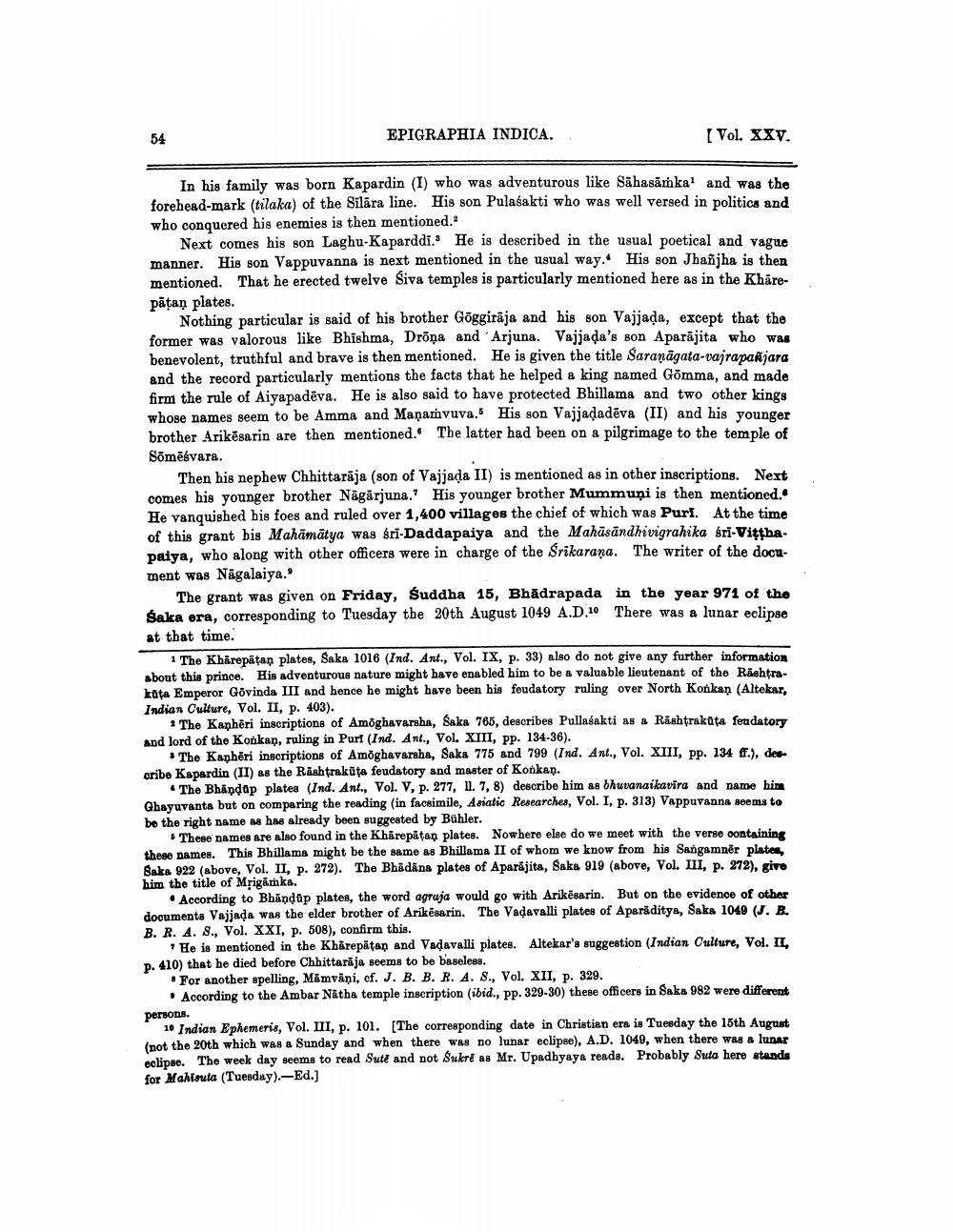________________
EPIGRAPHIA INDICA.
[Vol. XXV.
In his family was born Kapardin (I) who was adventurous like Sähasankal and was the forehead-mark (tilaka) of the Silāra line. His son Pulasakti who was well versed in politics and who conquered his enemies is then mentioned.
Next comes his son Laghu-Kaparddi. He is described in the usual poetical and vague manner. His son Vappuvanna is next mentioned in the usual way. His son Jhanjha is then mentioned. That he erected twelve Siva temples is particularly mentioned here as in the Kharepātan plates.
Nothing particular is said of his brother Göggirāja and his son Vajjada, except that the former was valorous like Bhishma, Dröna and Arjuna. Vajjada's son Aparajita who was benevolent, truthful and brave is then mentioned. He is given the title Saranāgata-vajrapaħjara and the record particularly mentions the facts that he helped a king named Gömma, and made firm the rule of Aiyapadēva. He is also said to have protected Bhillama and two other kings whose names seem to be Amma and Manamvuva. His son Vajjadadēva (II) and his younger brother Arikësarin are then mentioned. The latter had been on a pilgrimage to the temple of Somēśvara.
Then his nephew Chhittarāja (son of Vajjada II) is mentioned as in other inscriptions. Next comes his younger brother Nāgārjuna.' His younger brother Mummuni is then mentioned.. He vanquished bis foes and ruled over 1,400 villages the chief of which was Puri. At the time of this grant bis Mahāmātya was sri-Daddapaiya and the Mahāsāndhivigrahika sri-Vittha. paiya, who along with other officers were in charge of the Srikarana. The writer of the document was Nāgalaiya.
The grant was given on Friday, Suddha 15, Bhadrapada in the year 971 of the Saka era, corresponding to Tuesday the 20th August 1049 A.D.10 There was a lunar eclipse at that time.
The Khårepätan plates, Saka 1016 (Ind. Ant., Vol. IX, p. 33) also do not give any further information about this prince. His adventurous nature might have enabled him to be a valuable lieutenant of the Rashtrakuta Emperor Govinda III and hence he might have been his foudatory ruling over North Konkan (Altekar. Indian Culture, Vol. II, p. 403).
* The Kaphēri inscriptions of Amöghavarsha, Saka 765, describes Pullasakti as a Rashtrakata feudatory and lord of the Konkan, ruling in Purf (Ind. Ant., Vol. XIII, pp. 134-36).
• The Kaphēri inscriptions of Amõghavarsha, Saka 775 and 799 (Ind. Ant., Vol. XIII, pp. 134 ff.), der oribe Kapardin (II) as the Rashtrakūta feudatory and master of Konkan.
The Bhandup plates (Ind. Ant., Vol. V, p. 277, 11. 7, 8) describe him as bhuvanaikavira and name him Ghayuvants but on comparing the reading (in facsimile, Asiatic Researches, Vol. I, p. 313) Vappuvanna seems to be the right name as has already been suggested by Bühler.
These names are also found in the Khārepatan plates. Nowhere else do we meet with the verse containing theme names. This Bhillams might be the same as Bhillama II of whom we know from his Sangamner plates, Baka 922 (above, Vol. II, p. 272). The Bhädäna plates of Aparajita, Saka 919 (above, Vol. III, p. 272), give him the title of Mrigamka.
• According to Bhandup plates, the word agruja would go with Arikësarin. But on the evidence of other documents Vajjada was the elder brother of Arikësarin. The Vadavalli plates of Aparaditya, Saka 1049 (J. B. B. R. A. 8., Vol. XXI, p. 508), confirm this.
He is mentioned in the Khårepätan and Vadavalli plates. Altekar's suggestion (Indian Culture, Vol. IL p. 410) that he died before Chhittarāja seems to be baseless.
For another spelling, Mámväņi, cf. J. B. B. R. A. 8., Vol. XII, p. 329.
. According to the Ambar Nätha temple inscription (ibid., pp. 329-30) these officers in Saka 982 were different persons.
10 Indian Ephemeris, Vol. III, p. 101. [The corresponding date in Christian era is Tuesday the 15th August (not the 20th which was a Sunday and when there was no lunar eclipse), A.D. 1049, when there was a lunar eclipse. The week day seems to read Sutt and not Sukri as Mr. Upadhyaya reads. Probably Suta here stands for Mahionta (Tuesday).-Ed.)




